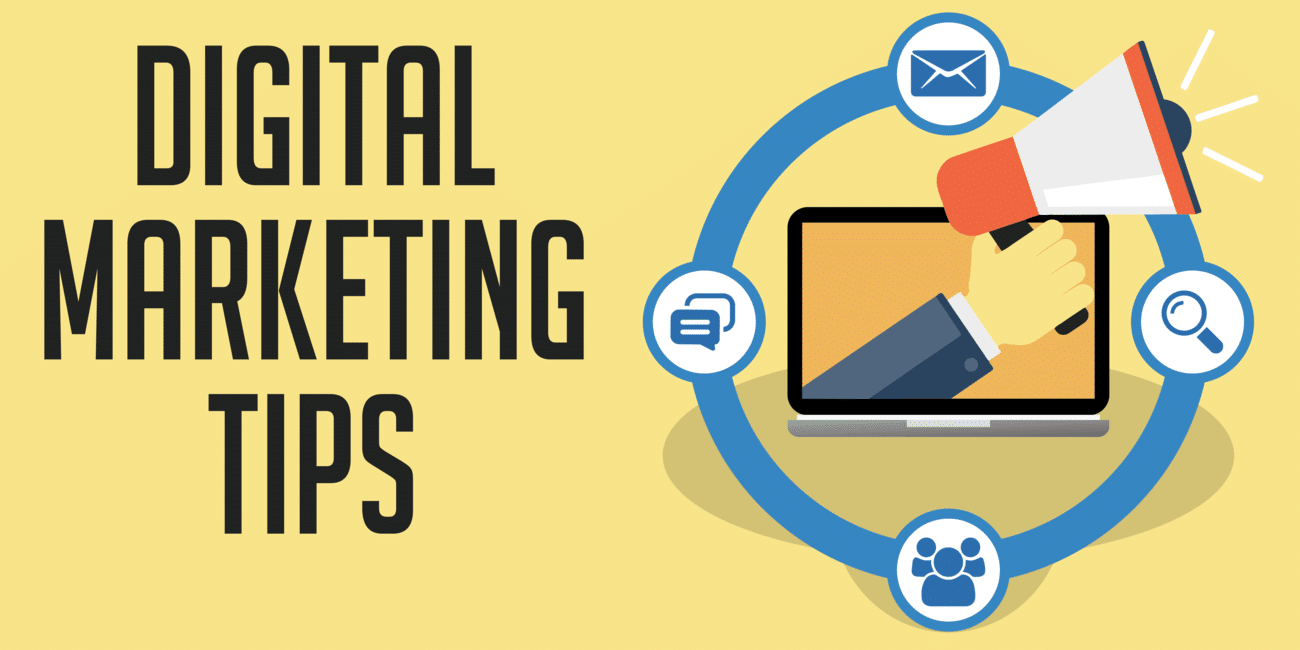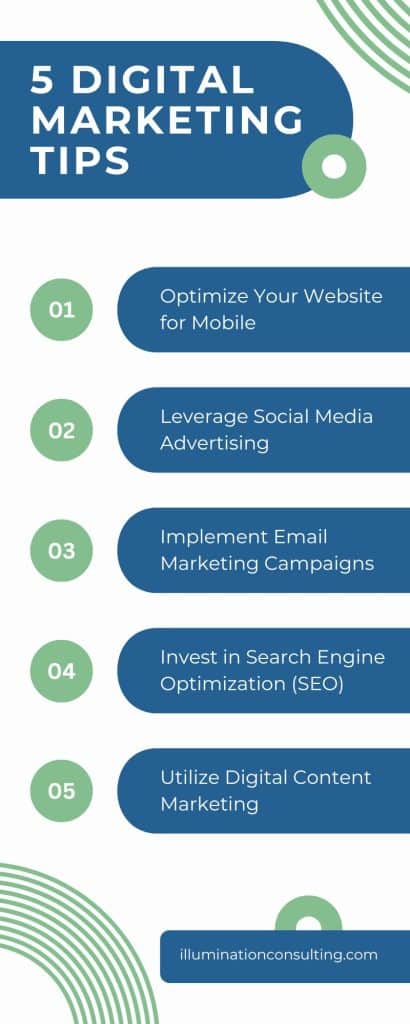 Digital marketing is essential for any business looking to succeed in today’s online world. With the right strategies, you can attract more customers, increase brand visibility, and drive sales. However, with so many options available, knowing where to focus your efforts can be challenging. In this article, we’ll cover five essential digital marketing tips to help your business grow. These tips include optimizing your website for mobile, leveraging social media advertising, implementing email marketing campaigns, investing in SEO, and utilizing digital content marketing.
Digital marketing is essential for any business looking to succeed in today’s online world. With the right strategies, you can attract more customers, increase brand visibility, and drive sales. However, with so many options available, knowing where to focus your efforts can be challenging. In this article, we’ll cover five essential digital marketing tips to help your business grow. These tips include optimizing your website for mobile, leveraging social media advertising, implementing email marketing campaigns, investing in SEO, and utilizing digital content marketing.
1. Optimize Your Website for Mobile
First and foremost, optimizing your website for mobile users is crucial. Mobile traffic now makes up more than half of all internet activity, so ensuring your website is mobile-friendly is key to capturing and retaining customers. A mobile-optimized site offers a seamless experience for users on smartphones and tablets, making it easy to navigate, view, and complete purchases.
Start by implementing a responsive design. A responsive website automatically adjusts its layout to fit any screen size, whether it’s a desktop, tablet, or smartphone. This ensures that all visitors, regardless of the device they use, have a smooth browsing experience.
Additionally, ensure that your site loads quickly on mobile devices. Slow-loading pages can cause visitors to leave before engaging with your content. Compress images, reduce heavy scripts, and use caching to improve load times. Fast-loading pages not only improve the user experience but also boost your rankings on search engines like Google, which prioritize mobile-friendly websites in their results.
Lastly, simplify your navigation and design for mobile users. Ensure that buttons are easy to tap, forms are short and user-friendly, and the checkout process is streamlined. A mobile-optimized site reduces friction and encourages visitors to stay longer and make purchases.
2. Leverage Social Media Advertising
Next, leveraging social media advertising is one of the most effective ways to reach a broader audience. Social media platforms like Facebook, Instagram, and LinkedIn offer powerful targeting options that allow you to reach specific demographics based on age, interests, location, and behaviors. By using social media ads, you can deliver highly personalized content to potential customers.
Start by choosing the right platform for your business. For example, Instagram and Pinterest are ideal for businesses that rely heavily on visuals, like fashion or beauty brands. LinkedIn, on the other hand, works well for B2B companies looking to reach professionals. Once you’ve selected the right platform, create ads that align with your audience’s interests and needs.
Moreover, experiment with different ad formats. Social media platforms offer various types of ads, including photo ads, video ads, carousel ads, and stories ads. Testing different formats can help you determine what resonates most with your audience and leads to higher engagement.
Additionally, take advantage of retargeting ads. Retargeting allows you to show ads to users who have previously visited your website or interacted with your brand. These ads remind users of your products or services, encouraging them to return to your site and complete a purchase.
3. Implement Email Marketing Campaigns
Another highly effective digital marketing strategy is email marketing. Email marketing allows you to engage directly with your audience, delivering personalized messages, offers, and updates straight to their inbox. A well-executed email marketing campaign can help build relationships with your customers, increase sales, and improve customer retention.
First, focus on building a quality email list. Offer incentives like discounts, free resources, or exclusive content to encourage website visitors to sign up for your newsletter. The more relevant your email list is, the more likely your emails are to generate engagement and conversions.
Moreover, segment your email list to send personalized content. By dividing your list based on factors like demographics, past purchases, or browsing behavior, you can tailor your messages to meet the specific needs of each group. For example, sending product recommendations based on a customer’s previous purchases can lead to higher click-through rates and sales.
Additionally, set up automated email campaigns. Welcome emails for new subscribers, abandoned cart reminders, and post-purchase follow-ups can all be automated, saving you time while maintaining customer engagement. These automated emails keep your brand top-of-mind and encourage customers to take action.
Finally, ensure that your emails are mobile-friendly. With a growing number of people reading emails on their phones, your content needs to be easy to read and interact with on smaller screens. Use concise text, clear call-to-action buttons, and a simple layout for optimal mobile performance.
4. Invest in Search Engine Optimization (SEO)
Investing in search engine optimization (SEO) is crucial for driving organic traffic to your website. SEO involves optimizing your website’s content and structure to rank higher in search engine results pages (SERPs). Higher rankings mean more visibility, which translates to more visitors and potential customers.
Start by conducting keyword research. Tools like Google Keyword Planner and Ahrefs can help you identify the most relevant and high-traffic keywords for your industry. Once you’ve identified these keywords, strategically place them in your website’s titles, headers, meta descriptions, and throughout your content.
Additionally, focus on producing high-quality content that answers the questions your target audience is searching for. Search engines prioritize websites that offer valuable, relevant, and well-written content. Regularly publishing blog posts, guides, and other resources will not only help improve your rankings but also position your brand as an authority in your niche.
Moreover, optimize your site’s technical elements. Ensure your website loads quickly, has clean and efficient code, and uses a secure HTTPS connection. Mobile optimization is also a key factor in SEO, so making sure your site is mobile-friendly will improve your rankings and user experience.
Lastly, build backlinks to increase your website’s authority. Backlinks are links from other reputable websites pointing to your site. Search engines view backlinks as a vote of confidence, helping to boost your rankings. You can build backlinks by guest posting on industry blogs, collaborating with influencers, or creating high-quality content that others want to link to.
5. Utilize Digital Content Marketing
Finally, utilizing digital content marketing is a powerful way to attract and engage potential customers. Content marketing involves creating valuable, informative, and relevant content that addresses your audience’s needs and pain points. By providing useful information, you build trust with your audience, driving traffic and encouraging conversions.
Start by developing a content strategy. Determine the types of content that resonate with your audience. For example, blog posts, videos, infographics, podcasts, and case studies can all be part of your content marketing efforts. Focus on answering common questions, offering helpful tips, or providing insights that align with your products or services.
Additionally, regularly update your blog with fresh content. A blog helps keep your website active and provides valuable information for both your audience and search engines. Posting consistent, high-quality content can improve your SEO rankings, drive organic traffic, and position your brand as an expert in your field.
Moreover, repurpose your content for different platforms. For instance, a blog post can be transformed into a video, infographic, or social media post. Repurposing content allows you to reach different audience segments across multiple channels, maximizing the impact of your marketing efforts.
Furthermore, promote your content through multiple channels, such as social media, email marketing, and influencer partnerships. By distributing your content widely, you increase its reach and the chances of attracting new leads.
 Conclusion
Conclusion
In conclusion, implementing effective digital marketing strategies is key to growing your business. By optimizing your website for mobile, leveraging social media advertising, implementing email marketing campaigns, investing in SEO, and utilizing content marketing, you can drive traffic, engage your audience, and boost sales. Consistently applying these five tips will help you stay competitive in the digital space and achieve long-term success.








